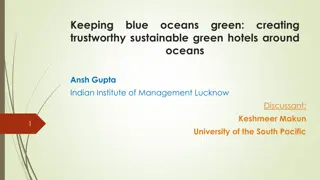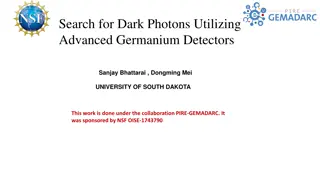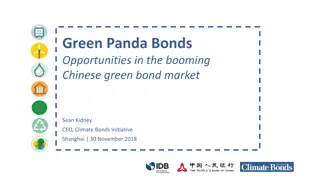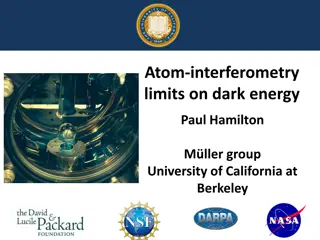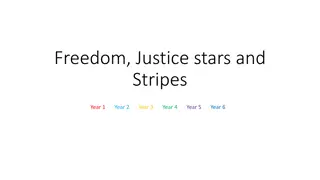
Environmental and Social Impact of Wind Energy Turbines
Explore the significant environmental and social issues surrounding the manufacturing, operation, and end-of-life of wind energy turbines. Issues such as rare earth metal extraction, geopolitical challenges, plastic waste, and end-of-life disposal are discussed, shedding light on the complex sustainability considerations of renewable energy technologies.
Download Presentation

Please find below an Image/Link to download the presentation.
The content on the website is provided AS IS for your information and personal use only. It may not be sold, licensed, or shared on other websites without obtaining consent from the author. If you encounter any issues during the download, it is possible that the publisher has removed the file from their server.
You are allowed to download the files provided on this website for personal or commercial use, subject to the condition that they are used lawfully. All files are the property of their respective owners.
The content on the website is provided AS IS for your information and personal use only. It may not be sold, licensed, or shared on other websites without obtaining consent from the author.
E N D
Presentation Transcript
THE DARK SHADOWS OF THE JOLLY GREEN GIANTS Dr Keith R. Skene BIOSPHERE RESEARCH INSTITUTE www.biosri.org
Dark shadows Significant environmental and social issues arise in terms of manufacturing and EoL and, to a lesser extent, during the lifetime of the turbine.
Wind energy construction issues SITE ISSUES MAGNETS PLASTICS
Magnets Neodymium magnets most efficient But require large quantities of rare Earth metals Extraction is an extremely toxic process Particularly damaging to child health The metals are geopolitical weapons Only 3-7% can be recycled. Wind turbine structure
Dangers of rare earth metal extraction Release of particulate matter Release of thorium Cross the blood-brain barrier Cause lung fibrosis Developmental issues in children Neurodegenerative impacts Renal and hepatic impacts Reduced fertilization Bioaccumulation.
Geopolitical issues Over the next 30 years, we will need to mine more mineral ores than humans have extracted over the last 70 000 years (Pitron, (2021) The Rare Metals War Scribe UK) By 2040 we will need to mine 3 times more rare earth metals, 12 times more cobalt and 16 times more lithium than today China produces 97% of rare earth metals.
PLASTICS The plastics are non-recyclable A 1 MW wind turbine needs 50 tonnes of plastic Glass fibre and carbon fibre Propylene is an important ingredient The process of manufacture is extremely energy expensive and waste includes hydrogen cyanide.
End-of-life issues: Avoiding a toxic landfill timebomb Wind turbines only last for 16-20 years Estimated non-recyclable plastic waste (deemed hazardous waste): 2 800 000 tonnes per year by 2050 Secondary markets for recycled plastics are insignificant Shredding costs too much Burning not an option.
At the heart of the issue lies the conflict between larger, longer- lasting, reliable, and therefore more efficient blades, and increasing challenges in EoL scenarios.
Ecological issues Compacted earth, deforestation and soil erosion around land-based wind farms Concerns have been raised that significant increases in the scale of wind turbine use could substantially impact atmospheric circulation and weather systems (Marvel et al., 2013).
Bird deaths: North Sea windfarms could cause the additional mortality of at least 2,000 gannets per year. Bat deaths: well over 600,000 bats may have been killed at wind energy facilities in 2012 alone.
A fuel shortage In 2021, wind provided only 7% of UK energy supply compared to 25% in 2020 Due to a decrease in wind This at a time when carbon credits have increased in price dramatically.
What can be done? REM magnets: use electromagnets, not permanent magnets no REMs Plastics: replace plastics with biodegradable plant-based materials (like the good old days) Site issues: simple markings on blades greatly reduce bird deaths (painting one blade black reduces deaths by 70%).
What can be done (II)? Ensure wind farms are not on migratory pathways by using GPS devices to inform site location decisions Reduce concrete in offshore farms Use radar to warn of incoming birds Microphones and weather monitoring for bats. All these measures bring reduced efficiencies and increased costs.
A brief history 2300 years ago: hydropower in Greece and China using waterwheel-driven trip- hammers to grind grain and ore 1606: Steam pump patent 1799: Wave power patent
Francis turbine 1848: First hydropower turbine (the Francis turbine) following on from earlier work by Benoit Fourneyron in 1826 Basic design still in use. James Francis Francis turbine
Hydropower today Some 40 000 dams now obstruct our largest rivers The largest hydroelectric plant is the Three Gorges Dam in China Producing 95.5 TW electricity annually Max: 112 TW in 2020 (112 trillion watts!!)
Itaipu Dam, Paraguay/Brazil 96.5 TW annually Max: 103 Tw (2016) Scotland has a population a little over 5 million and requires 25 TWh of electrical energy each year.
Geopolitical issues Since 1947, water has been at the centre of 150 conflicts Concerns arise over damming of transboundary rivers such as the Mekong, Salween, Irrawaddi and Nile
Geopolitical issues: The Grand Ethiopian Renaissance Dam
Russia Tigray UK THE GRAND ETHIOPIAN RENNAISANCE DAM Egypt Eritrea Sudan USA Ethiopia
Social disruption Aswan Dam: 100 000 people displaced Three Gorges Dam: 1.3 million people displaced Destruction of sacred burial grounds and cultural practices.
Cultural impacts Longitudinal research by Wilmsen and Van Hulten (2017) has indicated that rural households relocated to new farming land fared better than rural households moved to urban areas Since culture is intertwined with landscape in rural areas, the complete eradication of this landscape devastates such cultures.
BERTA CCERES Honduras Winner of the Goldman Environmental Prize Led protests against the Agua Zarca hydroelectric dam Shot dead in her home.
Dam Failures: Vajont Dam, Italy 1963 2000 dead
Banqiao Reservoir Dam Failure, 1975 200 000 dead
Construction costs Flooded land releases large amounts of CO2 and CH4 Huge amounts of concrete and steel involved in construction Impact on fish migrations Sediment issues Assam Dam Vulnerable to climate destabilization.
Salinization of groundwater Lower freshwater flow leads to increase in estuary salinity and underground salinization In addition to delta erosion Sediment can become toxic due to anaerobic conditions.
Micro-hydropower Use of small turbines in rivers and at weirs can generate small amounts of electricity, avoiding the issues with large plants A localist, off-grid approach Excellent for rural and mountainous areas, allowing energy independence based on landscape.
Urgent priorities Policies to drive distributed electric grid, encompassing micro- hydroelectric units; urgent research into threat of climate destabilization on hydrological cycles and their potential disruption to dams; Resolving conflict issues; Protecting local communities.



